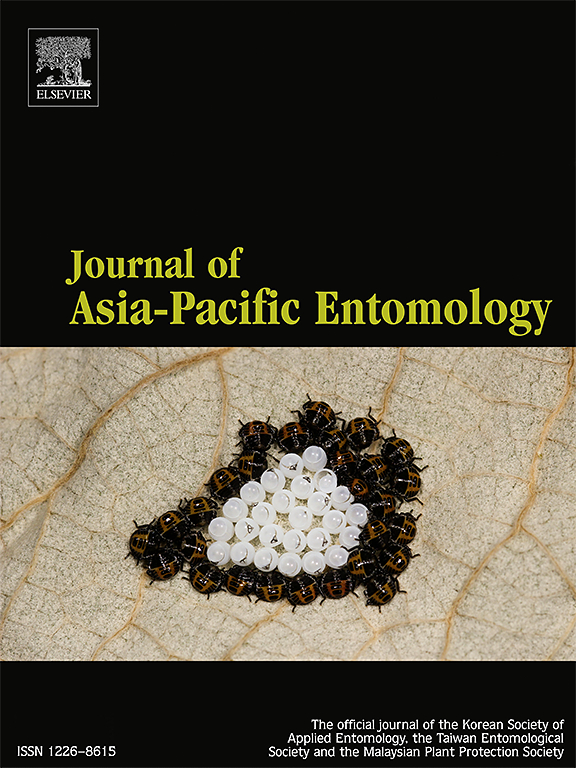Elucidating insect-virus associations in black pepper: Mealybug and tending ant influences on viral incidence in East Malaysia, Borneo
IF 1.3
3区 农林科学
Q3 ENTOMOLOGY
引用次数: 0
Abstract
Piper nigrum, a key agricultural commodity in Sarawak, East Malaysia, is highly susceptible to the Piper yellow mottle virus (PYMoV), a badnavirus transmitted by mealybugs. This study aimed to identify the mealybug and tending ant species associated with black pepper plantations in Sarawak and assess the presence of PYMoV in mealybugs. Insects were collected from four divisions namely Kuching, Sibu, Bintulu, and Miri between 2020 and 2022. Species identification was performed using morphological and DNA barcoding techniques, while molecular methods were employed to detect PYMoV. Seven mealybug species were identified: Planococcus minor, Ferrisia virgata, Dysmicoccus lepelleyi, Planococcus sp., Pseudococcus sp., Phenacoccus sp., and Exallomochlus sp., with percentage identity ranging from 94.05 % to 100 %. Additionally, 14 tending ant species were identified, including Tapinoma indicum, Meranoplus bicolor, Anoplolepis gracilipes, Pheidole sauteri, Iridomyrmex anceps, Tetramorium cognatum, Crematogaster rogenhoferi, Camponotus sp., Dolichoderus sp., Leptogenys sp., and four distinct Crematogaster species, with accuracies between 85.29 % and 100 %. PYMoV was detected in 6.58 % of the mealybugs, with P. minor and Phenacoccus sp. identified as hosts, the latter being a novel discovery. No significant association was found between specific mealybug species and PYMoV prevalence (p = 0.99), suggesting that other factors may influence viral transmission. However, a strong positive correlation (r = 1.00, p < 0.05) was observed between ant presence and mealybug infestation, indicating that ants may facilitate mealybug dispersal. These findings highlight the necessity for continuous surveillance of mealybugs and tending ants to mitigate the spread of PYMoV and protect black pepper cultivation in Sarawak.

阐明黑胡椒中昆虫-病毒的关联:粉蚧和趋向蚁对婆罗洲东马来西亚病毒发病率的影响
Piper nigrum是东马来西亚沙捞越的重要农产品,对Piper yellow mottle virus (PYMoV)高度敏感,PYMoV是一种由粉蚧传播的有害病毒。本研究旨在鉴定砂拉越黑胡椒种植相关的粉蚧和抚育蚁种类,并评估PYMoV在粉蚧中的存在。在2020年至2022年期间,在古晋、西巫、民都鲁和美里四个地区收集了昆虫。物种鉴定采用形态学和DNA条形码技术,PYMoV检测采用分子方法。鉴定出7种粉蚧,分别为:minor Planococcus、Ferrisia virgata、Dysmicoccus lepelleyi、Planococcus sp.、Pseudococcus sp.、Phenacoccus sp.和Exallomochlus sp.,鉴定率为94.05% ~ 100%。此外,鉴定出14种照看蚁,包括Tapinoma indicum、Meranoplus bicolor、Anoplolepis gracilipes、Pheidole sauteri、Iridomyrmex anceps、Tetramorium cognatum、Crematogaster rogenhoferi、Camponotus sp、Dolichoderus sp、Leptogenys sp和4种不同的Crematogaster,准确率在85.29% ~ 100%之间。PYMoV在6.58%的粉蚧中检出,其中以P. minor和Phenacoccus sp.为宿主,后者是新发现的宿主。特定粉蚧种类与PYMoV患病率之间无显著相关性(p = 0.99),提示其他因素可能影响病毒传播。然而,两者之间存在很强的正相关(r = 1.00, p <;0.05),说明蚂蚁的存在有助于粉蚧的传播。这些发现强调了对粉蚧和抚育蚂蚁进行持续监测的必要性,以减轻PYMoV的传播并保护砂拉越黑胡椒的种植。
本文章由计算机程序翻译,如有差异,请以英文原文为准。
求助全文
约1分钟内获得全文
求助全文
来源期刊

Journal of Asia-pacific Entomology
Agricultural and Biological Sciences-Insect Science
CiteScore
2.70
自引率
6.70%
发文量
152
审稿时长
69 days
期刊介绍:
The journal publishes original research papers, review articles and short communications in the basic and applied area concerning insects, mites or other arthropods and nematodes of economic importance in agriculture, forestry, industry, human and animal health, and natural resource and environment management, and is the official journal of the Korean Society of Applied Entomology and the Taiwan Entomological Society.
 求助内容:
求助内容: 应助结果提醒方式:
应助结果提醒方式:


